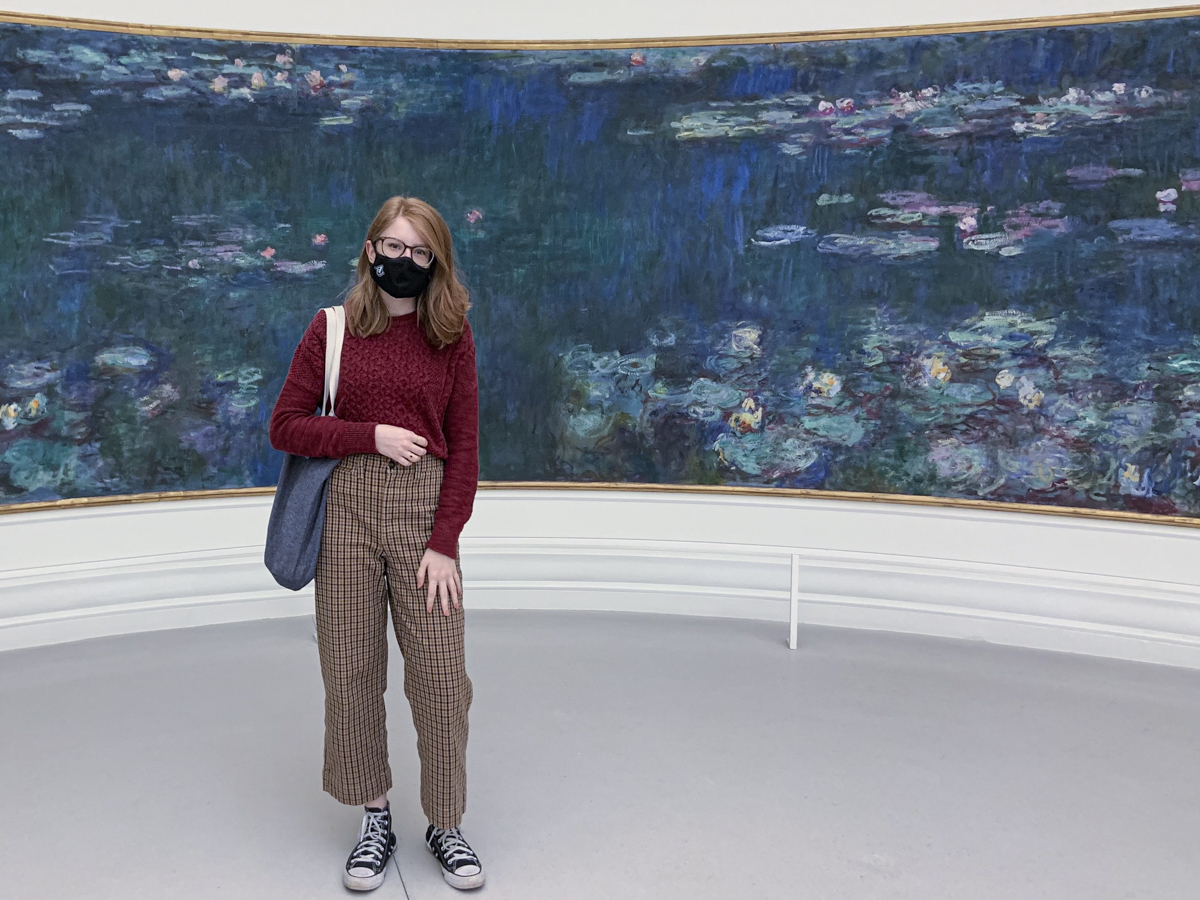STORY BY HAILEY SMALL
I turn the corner and am jolted by fluid splashes of color—original blues, greens, and oranges, not their recreated versions. Then I hear myself sigh, easing from the city into this quiet space.
When Monet designed the WaterLilies galleries in Le Musée de l’Orangerie, he specified that they should be experienced in silence. Viewers should whisper, step softly. It’s a space set apart—a cathedral built in reverence for the absence of sound.
The constant babble of Paris has worn on me over my six weeks here. The garbage trucks in the morning, the beeping of the metro doors, bike bells, constant hammering, pigeon coos—these things have become white noise, a buzzing that fades, a consistent arrhythmia. The pause in this gallery, this silent space, is a shock to my over-paced heart.
Hard steps of the brunette woman’s leather boots hit the stone floor surface, rippling. Fake shutter clicking from an elderly man snapping pictures with an iPad. A giggling couple wearing matching Nikes, swooshes flicking the same shade as Monet’s blue. Fake leather chairs squish and slip as tourists slide into the seats. As I pace and settle, my own steps echoing, I realize that this is not a silent space. Instead, the volume trickles from the city’s shouts to a pondside mumble.
I find a seat on the round, gray chair in the center in the room and watch the swatches of water shift on the canvas. I remember the drifting sound of my own home. I feel the cool breeze of a Kentucky fall, the air lifting off the bouncing stream below my favorite bridge. Sharp knocks of Kentucky woodpeckers pierce, and the chickadee call bounces. Instead of walking trails on my hikes, I wander through the undergrowth, adventuring for some small, forgotten spot of dirt, listening for running water. Little creeks are never hard to find, especially after rain, and I wander after some bubbling rush.
There is invitation in these little sounds, an instinctual draw towards what we can just barely hear. If I am willing to listen carefully, the woodpecker himself will call me close. When the world goes quiet, I am called to listen in order to hear. Here, I can identify the English-speaking tourists, if only I find a close spot to eavesdrop. I decipher direction, not by honking horns or the squeal of bike tires, but through the subtle approach of footsteps.
I glance around the room and see a blonde girl, 20-something, in a blue dress and matching headband, carrying a New Yorker tote bag. She wanders around the edge of the gallery, admiring the canvases. She steps into my line of sight like a shadow on the water. She whispers something that sounds like English to her two friends, who follow close behind. She’s my age. She’s speaking English. She’s carrying a cool, American tote bag.
“Would you mind taking my picture, just over by the paintings?” I hold my phone out to her, camera open. She’s hesitant, but she takes the phone and asks about the composition, if I’d like the picture to be tall or wide, a fully body shot or zoomed in. I direct her and the phone clicks. Together, she and I introduce more sound to the quieted room.

As I listen to her and her friends amble into the next room, I realize that it is not their shoes that make sound. The shoes themselves are silent—the sound is the click of rubber touching concrete, the sound of connection as the two meet. The iPad shutter click is the result of a finger on a button. The gray leather squish is body on fabric on chair. My request for the picture, our discussion of angles and perspectives and compositions, is the sound of two people connecting, touching, even just as our breath mingles together in the room.
Did we distract from the quiet? Did we breach Monet’s intentions for silence, misunderstanding his final masterpieces? Is sound really something to be grieved?
I never grieve the drilling of the woodpecker into oak or the popping of a creek against the rocks. I celebrate these connections of sound. I doubt Monet was bothered by the whine of wind in the reeds or the ping of water drops on the surface of his ponds, reverberating in circles like little waves. When Monet asked for silence in his gallery, I don’t think he really wanted silence. Instead, I think he wanted dimmed, intentional quiet. Monet calls us to listen closer, to acknowledge the piercing of boot heels, to experience the intimacy of asking a stranger for a picture.
Sounds of Paris, too, must be the sounds of millions of connections, all their vibrations. The ding of metal hitting metal on a bike bell. Hammer hitting nail. Exit door sliding through its frame. Tire skid on asphalt. Millions of Parisians and tourists running, the buzzing air over their vocal cords, their hearts always thumping, as they let me bounce among them.

Hailey Small is a poet, editor, and recent college graduate. Her writing is always grounded in place; she explores and depicts how people and their environments reflect one another. To read more of her work, find her elsewhere on Anthrow Circus, or in The Asbury Review, Kentucky Monthly, or The Linden Review.


